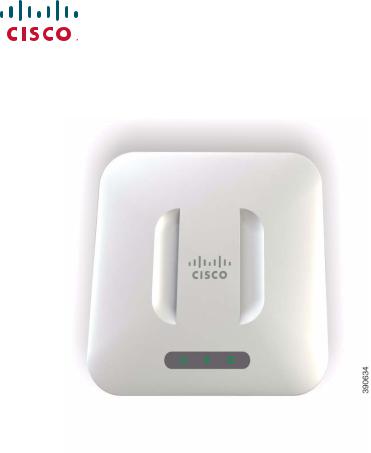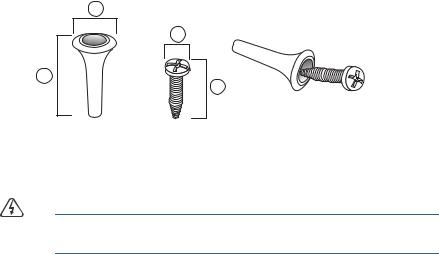Cisco WAP371 Manual

Quick Start Guide Guide de démarrage rapide
Cisco Small Business
371 Series Wireless Access Point
Point d'accès sans fil Série 371 371

Welcome
Thank you for choosing the Cisco Small Business WAP371 Wireless Access Point. The Cisco WAP371 is an indoor dual radio 802.11ac + 802.11n access point.
This guide is designed to familiarize you with the general layout of the access point, describe how to deploy the device in your network, and describe how to configure the device. Your access point has more features and functionality than what is described in this guide. For additional information, see the Administration Guide. A link to the Administration Guide is found in “Where to Go From Here” on page 11.
Package Contents
• Wireless Access Point
• Mounting kit
• This Quick Start Guide
• Product CD
• Ethernet cable
1 Before You Begin
Before you begin the installation, make sure that you have the following equipment and services:
•A computer with browser support for:
–Internet Explorer v7.0 or later
–Chrome v5.0 or later
–Firefox v3.0 or later
–Safari v3.0 or later
•Tools for installing the hardware
•One or more Ethernet network switches with PoE
|
Cisco WAP371 Wireless-AC/N Dual Radio Access |
|
2 |
||
Point with Single Point Setup Features |
Front Panel
The front panel of the device consists of three lights: Power, WLAN, and LAN. For full descriptions of the colors of the lights and their indications, see “Verifying the Hardware Installation”.
2 |
Cisco Small Business WAP371 Series Wireless Access Point |
A Kensington lock slot is found under the lights.
Back Panel
The back panel of the device has an RJ-45 Ethernet port. Use the Ethernet port to power your device using PoE. It is an auto-sensing, Gigabit Ethernet (802.3) port used to connect your WAP devices to network devices, such as computers, routers, or switches. We strongly recommend that you use a Category 5e or better cable for gigabit connectivity.
The back panel of the device has a Reset button. See “Rebooting the Devices or Returning them to their Factory Default Settings” for information on the Reset button.
Default Settings |
|
|
|
Parameter |
Default Value |
|
|
Username |
cisco |
|
|
Password |
cisco |
|
|
LAN IP Address |
DHCP address assigned by |
|
server |
|
|
Fallback LAN IP |
192.168.1.245 |
|
|
Subnetwork Mask |
255.255.255.0 |
|
|
If you are using a Cisco Small Business RV Series router, the default range for the DHCP assigned address is from 192.168.1.100 to 192.168.1.254. Any device connecting to the same LAN will be assigned an IP address in this range.
Cisco Small Business WAP371 Series Wireless Access Point |
3 |

|
Mounting the Cisco WAP371 Wireless-AC/N Dual |
|
3 |
||
Radio Access Point with Single Point Setup |
You can place your access point on a desktop, or mount it on a wall or ceiling.
Placement Tips
•Ambient Temperature—To prevent the access point from overheating, do not operate it in an area that exceeds an ambient temperature of 104°F (40°C).
•Air Flow—Both side panels have vents that must be unobstructed to prevent overheating.
•Mechanical Loading—The device should be level, stable, and secure to prevent it from sliding or shifting out of position.
Wall and Ceiling Mounting
The Cisco WAP371 device can be wall or ceiling-mounted. A mounting kit is packaged with your device. The kit is designed to install your device to the wall or the ceiling.
The mounting bracket has some flexibility so that you can reuse existing holes drilled for a Cisco WAP551 or WAP561 device. The installer can remove the Cisco WAP551 or WAP561 and mount the Cisco WAP371.
The dimensions for the mount kit screws are as follows:
1
|
3 |
|
|
2 |
|
4 |
|
|
|
|
|
|
|
|
<![if ! IE]> <![endif]>196243 |
1 .31 to .33 in (7.8 |
2 .86 to .88 in (21.8 |
3 .22 to .24 in (5.5 |
4 .69 to .72 in (17.5 |
to 8.3 mm) |
to 22.3 mm) |
to 6.0 mm) |
to 18.2 mm) |
WARNING Insecure mounting might damage the device or cause injury. Cisco is not responsible for damages incurred by insecure wall or ceiling mounting.
4 |
Cisco Small Business WAP371 Series Wireless Access Point |

To mount the Cisco WAP 371 device to a wall or ceiling:
STEP |
1 |
Determine where you want to mount the device. Verify that the surface is |
|
|
smooth, flat, dry, and sturdy. |
STEP |
2 |
Drill two pilot holes into the surface 2.75 inches (70 mm) apart for your |
|
|
Cisco WAP device. |
STEP |
3 |
Insert a screw into each hole, leaving a gap between the surface and the base |
|
|
of the screw head. |
STEP |
4 |
Place the upper slots of the bracket over the screws, adjust the screws |
|
|
accordingly, and slide the bracket down until the screws fit snugly into the |
|
|
slots. |
STEP |
5 |
Using the bracket as a template, drill two more holes for the lower screws. |
STEP |
6 |
Insert a screw into each lower hole. |
STEP |
7 |
Slide the WAP device into the bracket, placing the cable through the break- |
|
|
out tab found in the back of the bracket. |
|
Connecting the Cisco WAP371 Wireless-AC/N |
|
4 |
||
Dual Radio Access Point with Single Point Setup |
The default configuration of the device has the Wi-Fi radio turned off. You must perform the initial configuration using a wired Ethernet connection. To connect the device to the wired network:
STEP |
1 |
Connect the Ethernet cable to the Ethernet port of a switch, a router, or a PC. |
STEP |
2 |
Connect the other end of the network Ethernet cable to the Ethernet port of |
|
|
the wireless access point. |
After installation, all lights should be active. Refer to Verifying the Hardware Installation, page 6 for details about the different lights on each switch.
Cisco Small Business WAP371 Series Wireless Access Point |
5 |

5 Verifying the Hardware Installation
To verify the hardware installation, complete the following tasks:
•Check the cable connections.
•Check the state of the indicator lights.
|
|
|
Label |
Activity |
Description |
Power |
Off |
The device has no power. |
|
Solid Green |
The device is powered on. Normal operation. |
|
Flashing Green |
Upgrading firmware or acquiring an IPv4 address. |
|
Solid Red |
Booting or firmware upgrade failed. |
WLAN |
Off |
Wireless is disabled, for both 2.4 GHz and 5 GHz. |
|
Solid |
Wireless is enabled. |
|
Green |
Concurrent mode enabled. (The intensity needs to be |
|
|
the same) |
|
|
|
|
Amber |
5 GHz is in use. |
|
Blue |
2.4 GHz is in use. |
|
Flashing |
Transmitting or receiving data. |
LAN |
Off |
No Ethernet link. |
|
Solid Green |
GE Ethernet link is active. |
|
Solid Amber |
FE Ethernet link is active. |
|
Flashing |
Transmitting or receiving data. |
NOTE If you need help resolving a problem, visit the Cisco Small Business Support Community at www.cisco.com/go/smallbizsupport.
6 |
Cisco Small Business WAP371 Series Wireless Access Point |

|
Getting Started with the Configuration |
6 |
To configure the wireless access points, follow these steps to access the Wizard and then the web-based configuration utility from your computer:
STEP 1 Connect the wireless access point to the same network (IP subnet) as your computer. The factory default IP address configuration of the access points is DHCP. Make sure your DHCP server is running and can be reached.
See “Incorrect IP Address” on page 9 for troubleshooting information, or if you do not have a DHCP server.
STEP 2 Locate the IP address of the wireless access point.
a.The wireless access points can be accessed and managed by Cisco Small Business network tools and services including the Cisco FindIT Network Discovery Utility that enables you to automatically discover all supported Cisco Small Business devices in the same local network segment as your computer. You can get a snapshot view of each device or launch the product configuration utility to view and configure the settings. For more information, see www.cisco.com/go/findit.
b.The wireless access points are Bonjour-enabled and automatically broadcast their services and listen for services being advertised by other Bonjour-enabled devices. If you have a Bonjour-enabled browser, such as Microsoft Internet Explorer with a Bonjour plug-in, or the Apple Mac Safari browser, you can find the wireless access point on your local network without knowing its IP address.
You can download the complete Bonjour for Microsoft Internet Explorer browser from Apple’s website by visiting: http://www.apple.com/bonjour/
c.Locate the IP address assigned by your DHCP server by accessing your router or DHCP server. See your DHCP server instructions for more information.
STEP |
3 |
Launch a web browser, such as Microsoft Internet Explorer or Mozilla |
|
|
|
Firefox. |
|
STEP |
4 |
In the Address field, enter the default DHCP address and press the Enter key. |
|
STEP |
5 |
Enter the default user name of cisco and password of cisco in the User Name |
|
|
|
and Password fields. |
|
STEP |
6 |
Click Login. The Wireless Access Point Setup Wizard appears. |
|
STEP |
7 |
Follow the Setup Wizard instructions to finish the WAP device installation. |
|
|
|
We strongly recommend that you use the Setup Wizard for the first |
|
|
|
installation.The Setup Wizard turns on the Wi-Fi radio, which allows you to |
|
Cisco Small Business WAP371 Series Wireless Access Point |
7 |
||

connect wirelessly. For more advanced configurations, see the Administration Guide. A link to the Administration Guide is found in “Where to Go From Here” on page 11.
Congratulations, you can now start using your wireless access point.
7 Suggested Next Steps
In case of an error while installing, try the following troubleshooting procedures described in this section:
Troubleshooting
If you cannot display the configuration utility, you can test the ability of the computer to communicate with the device by using ping. To use ping on a computer running Windows:
STEP |
1 |
Verify that the Cisco WAP371 is powered on and the lights indicate the |
|
|
appropriate links. |
STEP |
2 |
Locate the device’s IP address. While there are different ways to locate your |
|
|
device’s IP address, this procedure uses Cisco FindIT. |
a.If you have previously downloaded Cisco FindIT, open Internet Explorer and launch Cisco FindIT. For more information on downloading Cisco FindIT, see www.cisco.com/go/findit.
b.In the Cisco FindIT display, place your mouse over the device’s name. The device IP address is displayed along with other device information.
STEP |
3 |
Open a command window by choosing Start > Run and enter cmd. |
STEP |
4 |
At the command window prompt, enter ping and the device IP address. In |
|
|
this example, we pinged 192.0.2.10. |
If successful, you should get a reply similar to the following:
Pinging 192.0.2.10 with 32 bytes of data:
Reply from 192.0.2.10: bytes=32 time<1ms TTL=128
If it fails, you should get a reply similar to the following:
Pinging 192.0.2.10 with 32 bytes of data:
Request timed out.
Possible Cause of Installation Failure
8 |
Cisco Small Business WAP371 Series Wireless Access Point |
Devices Cant Connect using Wi-Fi
•Complete the Setup Wizard. The Wi-Fi radio on the device is turned off by default, and the Setup Wizard activates it. For users who do not want to use the Setup Wizard, log into the device using a Category 5e Ethernet cable, and activate the Wi-Fi radio manually. See the Administration Guide for details on activating the Wi-Fi radio.
No Power
•Power up the switch and your computer if they are turned off.
•Make sure your PoE switch is powered on and the lights indicate that you have a link. See “Verifying the Hardware Installation” on page 6.
•Verify that the devices on your network are not plugged into a switchable outlet.
Bad Ethernet Connection
•Check the state of the indicator lights. See “Verifying the Hardware Installation” on page 6.
•Check the Ethernet cable to ensure that it is firmly connected to your devices. Devices connected by the Ethernet cable can include the WAP device, and routers, any switches, and your computer.
•Verify the connected switch has auto-negotiation enabled. The access point and the switch need the same negotiation parameters set.
Bad Image
After a new firmware installation, if the Power light is flashing quickly, contact system support; see “Where to Go From Here” on page 11.
Incorrect IP Address
The most likely cause of connectivity failure is an incorrect IP address. The Web browser may be pointing to the wrong IP address, or your computer may be configured with an IP address that is not in the same subnet as the device.
Because the factory default IP address configuration is DHCP, make sure that your DHCP server is running and can be reached. You may need to disconnect and reconnect the devices for them to discover their new IP addresses from the DHCP server. You can then query the DHCP server for the new IP address. See Step 2 of “Getting Started with the Configuration” on page 7 for more information on how to find the DHCP address.
If the wireless access points do not receive a DHCP response (there is no DHCP server on your network) after 60 seconds, the access points will fallback to the following default static IP address: 192.168.1.245 and a default mask of 255.255.255.0. To reach that IP address, be sure that your computer is on the 192.168.1.xxx network.
Cisco Small Business WAP371 Series Wireless Access Point |
9 |

|
Rebooting the Devices or Returning them to their |
|
8 |
||
Factory Default Settings |
To reboot your device:
•When the power supply is PoE, unplug your Ethernet connection for three seconds and plug it back in.
or
•With the power on, press the Reset button with an opened paperclip for less than three seconds, or until the lights go off.
–When all the lights go off, release the Reset button.
–Release the Reset button as soon as the lights go off, or you will restore the device to factory default settings and lose your configurations.
To reset the device to factory default settings:
•With the power on, press and hold the Reset button with an opened paperclip for more than 10 seconds.
–All of the lights will go off.
–Release the Reset button when the power light turns on.
10 |
Cisco Small Business WAP371 Series Wireless Access Point |
|
|
Where to Go From Here |
|
9 |
|
||
|
|
|
|
Support |
|
|
|
|
|
|
|
Cisco Small Business |
www.cisco.com/go/smallbizsupport |
||
Support Community |
|
||
|
|
|
|
Cisco Small Business |
www.cisco.com/go/smallbizhelp |
||
Support and Resources |
|
||
|
|
|
|
Phone Support Contacts |
www.cisco.com/en/US/support/ |
||
|
|
|
tsd_cisco_small_business |
|
|
|
_support_center_contacts.html |
|
|
|
|
Cisco Small Business |
www.cisco.com/go/smallbizfirmware |
||
Firmware Downloads |
Select a link to download firmware for Cisco Small |
||
|
|
|
|
|
|
|
Business Products. No login is required. |
|
|
|
Downloads for all other Cisco Small Business |
|
|
|
products, including Network Storage Systems, are |
|
|
|
available in the Download area on Cisco.com at |
|
|
|
www.cisco.com/go/software (registration/login |
|
|
|
required). |
|
|
|
|
Cisco Small Business Open |
www.cisco.com/go/smallbiz_opensource_request |
||
Source Requests |
|
||
|
|
|
|
Product Documentation |
|
||
|
|
|
|
Cisco Small Business |
www.cisco.com/go/500_wap_resources |
||
WAP551 and WAP561 |
|
||
Administration Guide |
|
||
|
|
|
|
Cisco Small Business Power |
Go to www.cisco.com/go/wap_accessories and |
||
Adapters |
|
select the Resources tab. Scroll down to Technical |
|
|
|
|
Documentation. |
|
|
|
|
Cisco Small Business |
|
||
|
|
|
|
Cisco Partner Central |
www.cisco.com/web/partners/sell/smb |
||
for Small Business (Partner |
|
||
Login Required) |
|
||
|
|
|
|
Cisco Small Business Home |
www.cisco.com/smb |
||
|
|
|
|
Cisco Small Business WAP371 Series Wireless Access Point |
11 |

Americas Headquarters
Cisco Systems, Inc. 170 West Tasman Drive
San Jose, CA 95134-1706 USA
www.cisco.com
Small Business Support, Global: www.cisco.com/go/sbsc
Cisco and the Cisco logo are trademarks or registered trademarks of Cisco and/or its affiliates in the U.S. and other countries. To view a list of Cisco trademarks, go to this URL: www.cisco.com/go/trademarks. Third-party trademarks mentioned are the property of their respective owners. The use of the word partner does not imply a partnership relationship between Cisco and any other company. (1110R)
© 2014 Cisco Systems, Inc. All rights reserved.
